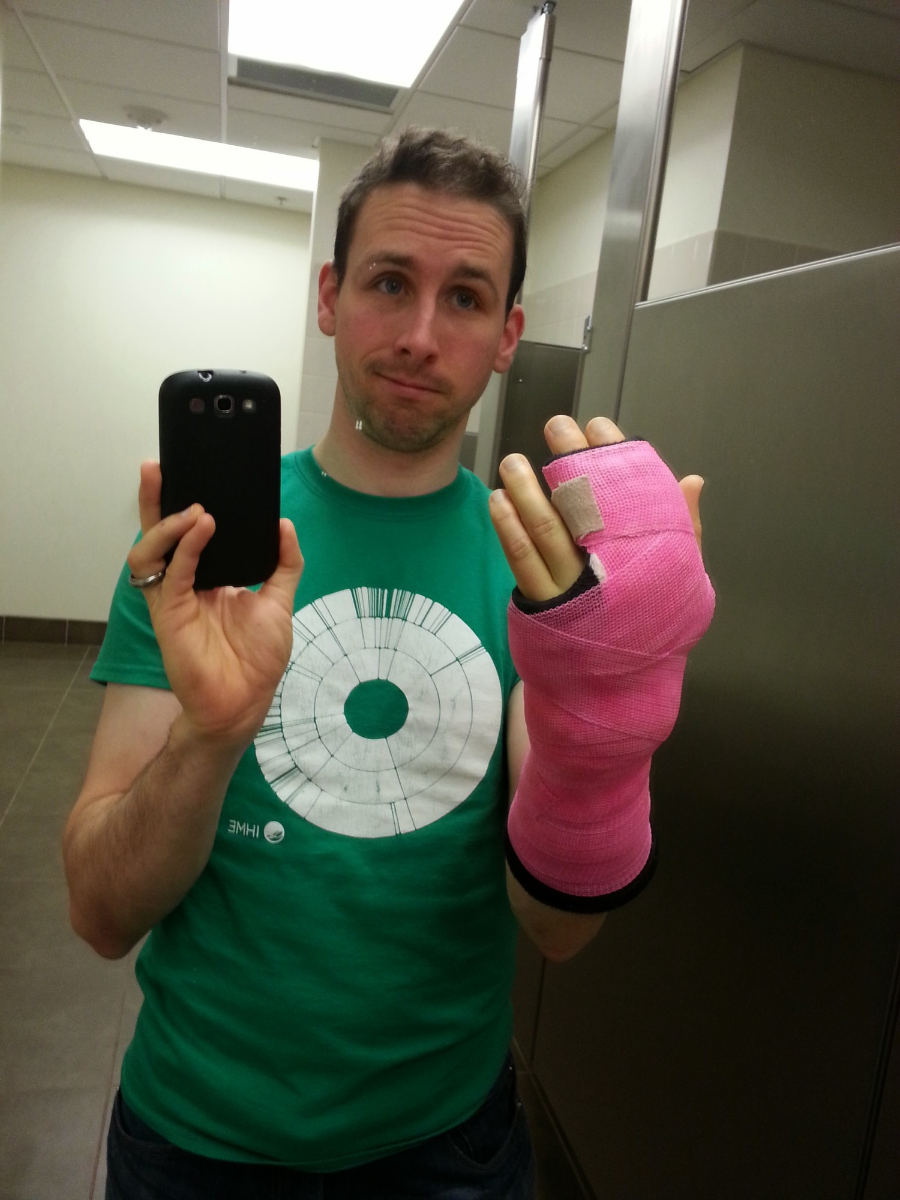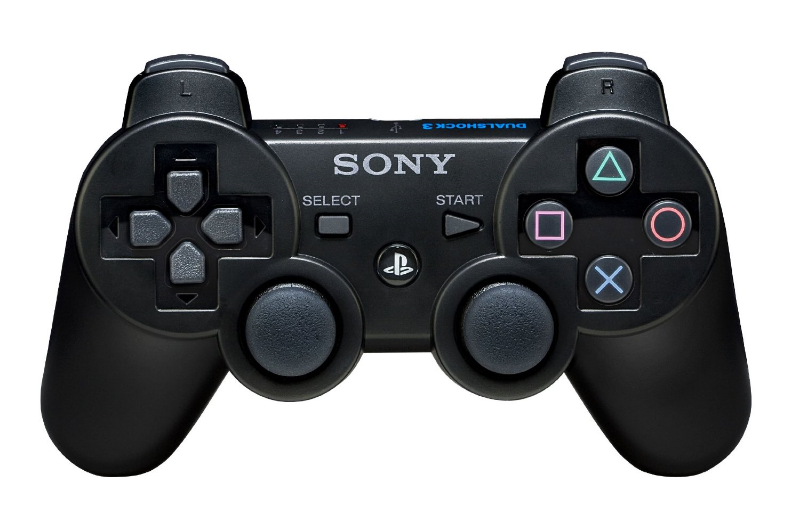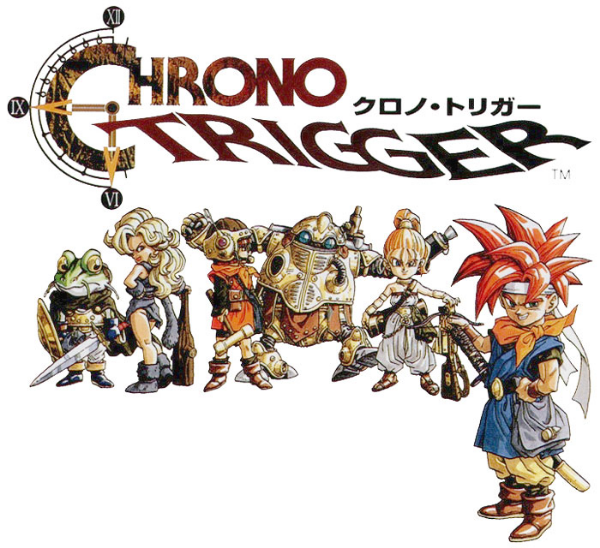Gaming with a Broken Hand
In late February 2015, I broke my right hand. It wasn’t anything catastrophic, I had just chipped the metacarpal head of index finger, essentially breaking my knuckle. While the fracture was very small, its proper healing would require the immobilization of my first and second fingers, as well as my wrist, with a cast.
Obligatory selfie, taken in the mirror at Harborview Medical Center, Seattle.
For six weeks, a bright pink cast covered my right hand and forearm (I chose the color myself) and made all aspects of my life considerably more challenging.
Working an office job and being right-handed, I suddenly needed to do all my work with my left. Typing with one hand is hard enough, but doing everything with your weak hand is doubly challenging. My heartfelt thanks to the Excel gods for hotkeys. Control, Shift, and of course Copy and Paste really saved me. Writing anything by hand, whether taking notes or applying my signature, was next to impossible. This meant paying for dinner with my debit card was not so convenient. Everything I needed to do I slowly and clumsily accomplished left-handed, whether it be shaving or using chopsticks.
Luckily, my thumb was free, so at least I could play some video games. Or could I…?
Yeah, well... Good luck with that.
I quickly discovered that the vast majority of modern games—most games from the PlayStation1 era and onward—make heavy use of their shoulder/trigger buttons. Not one of my PS3 games was playable with my index finger encased in fiberglass. In fact, it was rather difficult to even hold a modern controller at all. My cast was fat enough around my first two fingers that even a Wii-mote held sideways (to emulate an NES controller) was just a little too thick to wield comfortably. It could be done, but not without extreme awkwardness. For a moment, it seemed like my entire video game collection would be useless to me until the cast came off.
Then I remembered a couple of used games I had recently purchased, original Game Boy games. The Game Boy Advance SP I intended to play them on did indeed have shoulder buttons, but these original GB titles wouldn’t use them. (The first Game Boy had only two primary buttons, of course.) One of these games was the legendary puzzle game Tetris, a classic if ever a classic there be. Event though I was sure I had a copy of Tetris somewhere, for four dollars I was happy to grab another as a backup. Another game I purchased was the first Game Boy Mega Man, a title I bought mostly out of nostalgia for my youth, and perhaps a bit out of self-hatred. That game is impossible, I tell you. Impossible.
And the third game, prophetically, was Dr. Mario.
While I had known of quite a few people that appreciated Dr. Mario back in the day, most of them had been older folks. When the game first came out in 1990, I remember thinking of it as an old fogey’s game. I suppose this was just because it was puzzle game, not the arcade action-adventure/fighting fare that my peers and I were into. Plus, as a falling block puzzle title it bore a strong resemblance to Tetris, the king of all casually accessible games. Your grandma might despise video games in general, but the odds are good that she likes Tetris. And so, once labeled as lame, I never anticipated that Dr. Mario would be much fun to play. But wow, was I ever wrong. Dr. Mario is awesome.
Even the original Game Boy version of Dr. Mario—a 25-year-old, black and white game about matching colored pellets—is awesome. And at a time when no game appeared accessible and I was dying for a carefree division, Dr. Mario scratched that itch perfectly. It was sweet catharsis to kick back with the Game Boy and play through level after level of virus-busting fun. The game was easy enough to get into, but eventually ramped up the difficulty until it pushed my brain’s processing speed to breaking point. Crushing failure was a good sign that it was time to put the game away.
Akira Toriyama, you are a badass.
While Dr. Mario definitely became my obsession over my six weeks in a cast, I also tried playing another type of game that my limited dexterity could definitely handle, the good old J-RPG. My limited mobility offered good timing to revisit one of the most classic games of the 16-bit era, Chrono Trigger. I didn’t make it very far into Chrono Trigger during this time (I was just too busy with Dr. Mario), but restarting the time traveling quest, I was immediately struck by the artistry that went into every aspect of the game. Music, story, character design, the teamwork element of the battle system, the seamless transitions into/out of battles, even the trial sequence early on that brilliantly punishes the player for normal RPG behaviors—Chrono Trigger was SquareSoft showing off at the height of their prowess. If you haven’t played it, you should really stop reading this, pick it up, and give it go. So good, so very good.
Over the years, I have definitely read about video games aiding in the healing process. Every time a soccer injury takes me out of commission for a stretch of time, my mind starts compiling a Games to Play list as soon as I return home. Naturally, I become anxious to play anytime that physical exercise isn’t possible. But in this instance, the extenuating circumstances made it a bit tough to find a game that worked for me.
And that’s one thing I’ve taken away from this experience: that these days, there is a good game available for most every situation. The key is just finding the one most suitable for your circumstances at this moment.
"I'm-a so sorry, but this is a suppository."
Maybe today is the day to tackle a classic Mega Man game. Perhaps Windows Solitaire is more your speed at the moment? Or—admittedly, this is less likely—you might feel like exploring something truly aged and beyond your time, like the text-based adventure Zork. Video Game history is vast enough, there’s so much out there to be played, that one has essentially an infinite selection to choose from.
And one thing I can attest, there is something oddly poetic about playing Dr. Mario in a doctor’s office waiting room.







